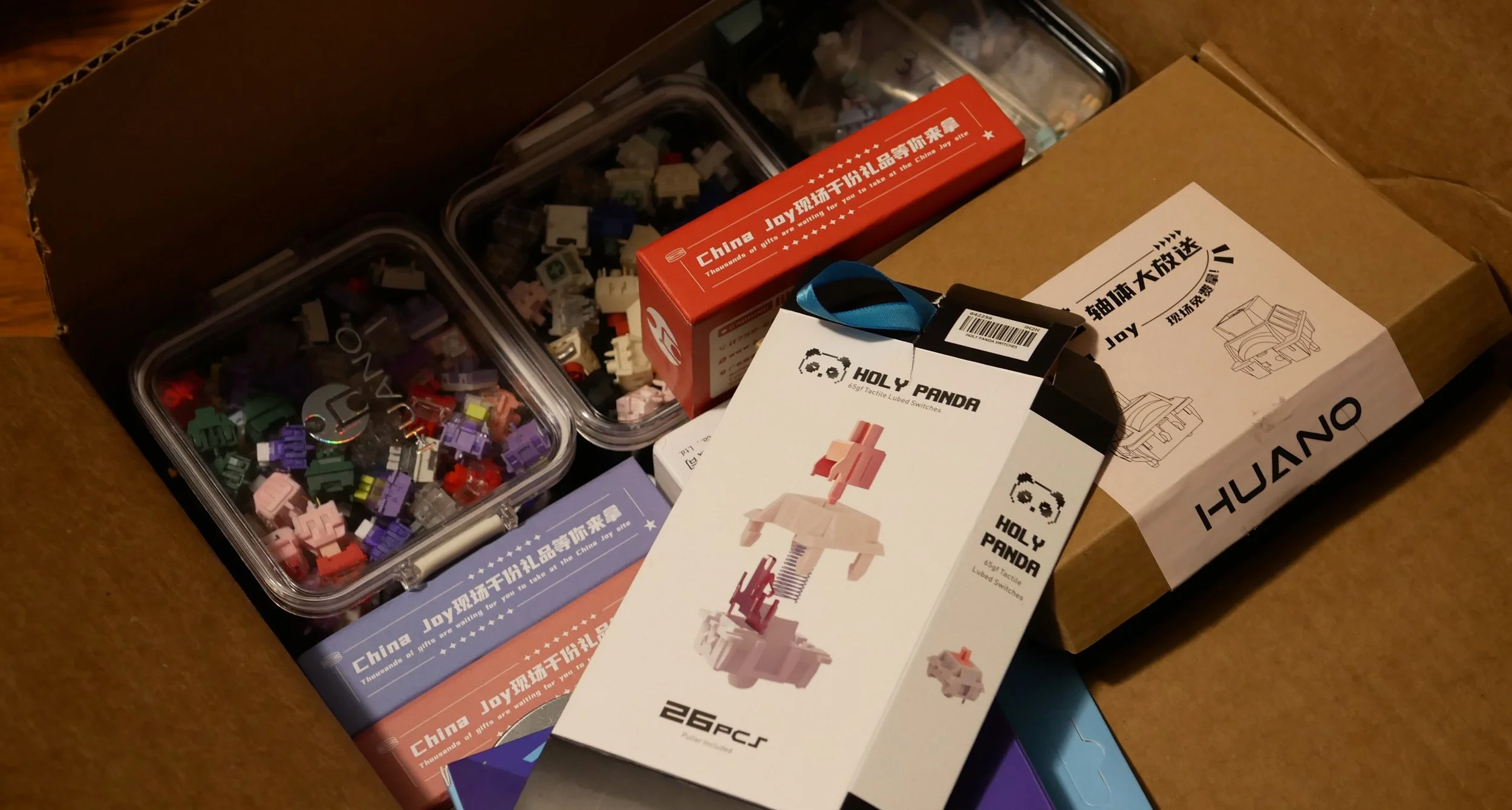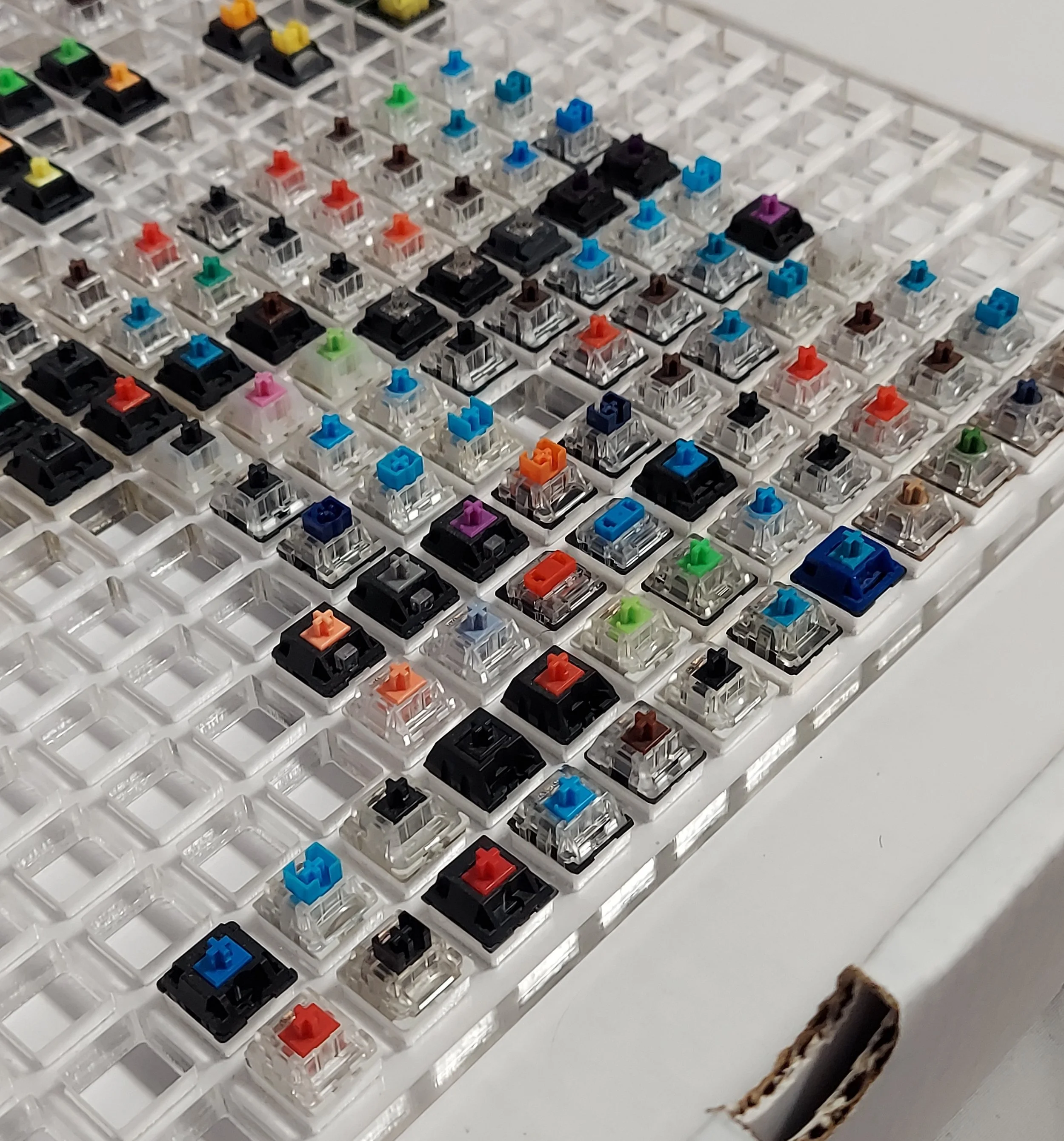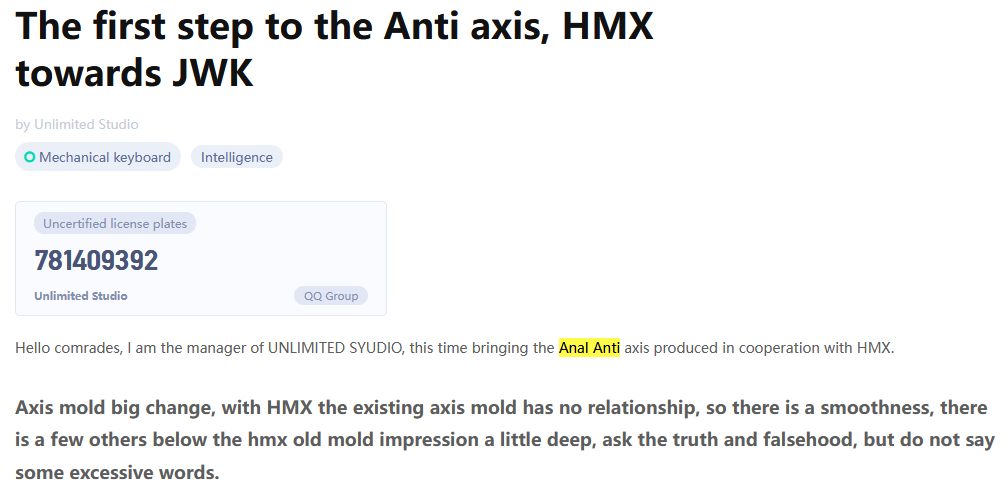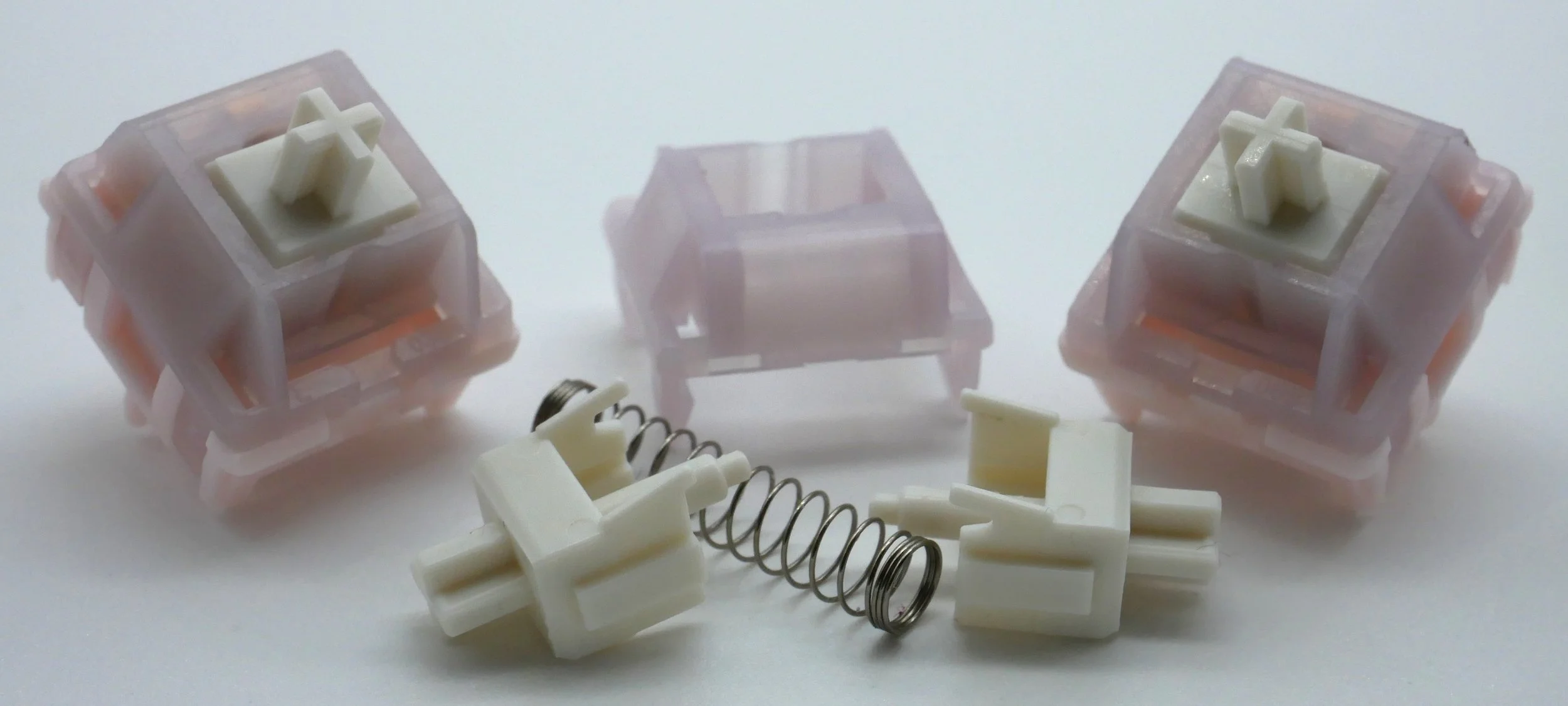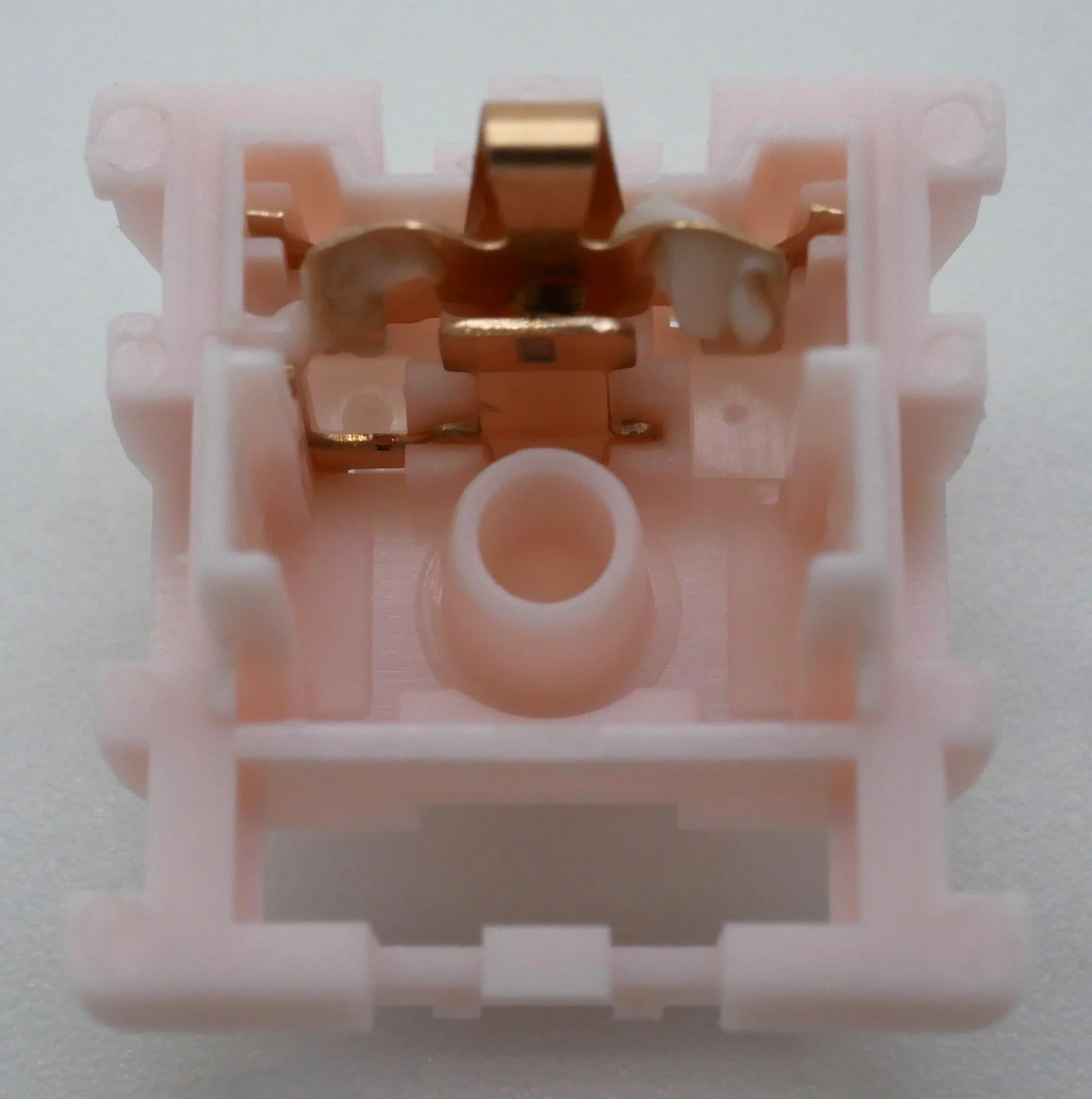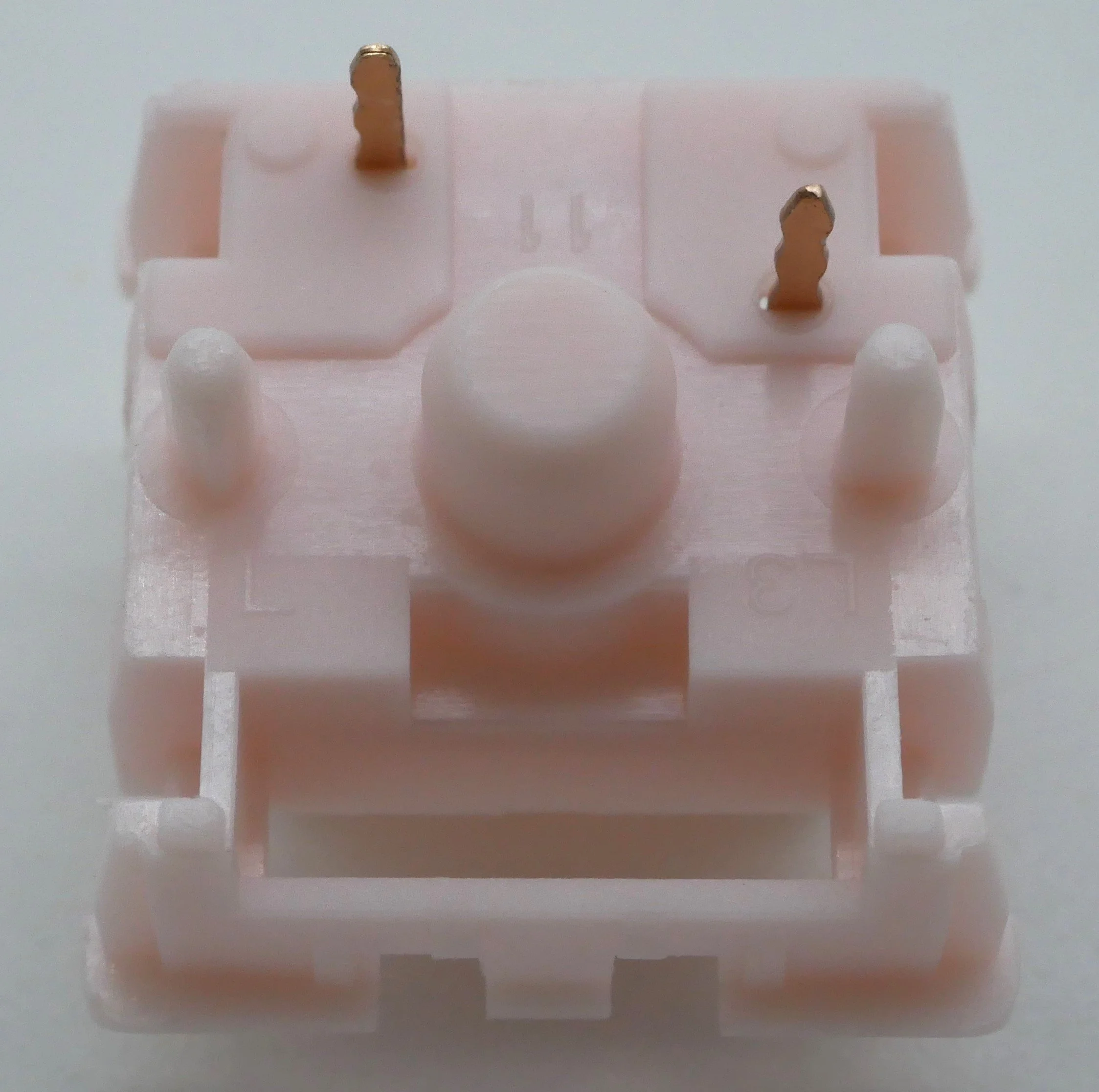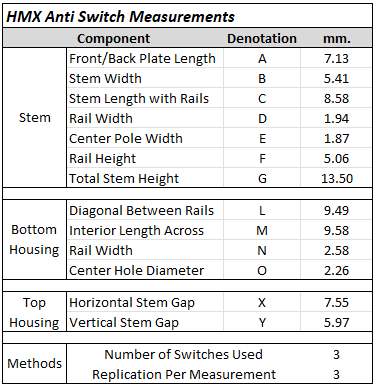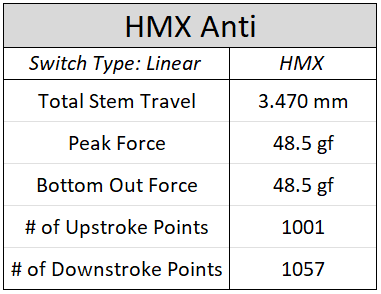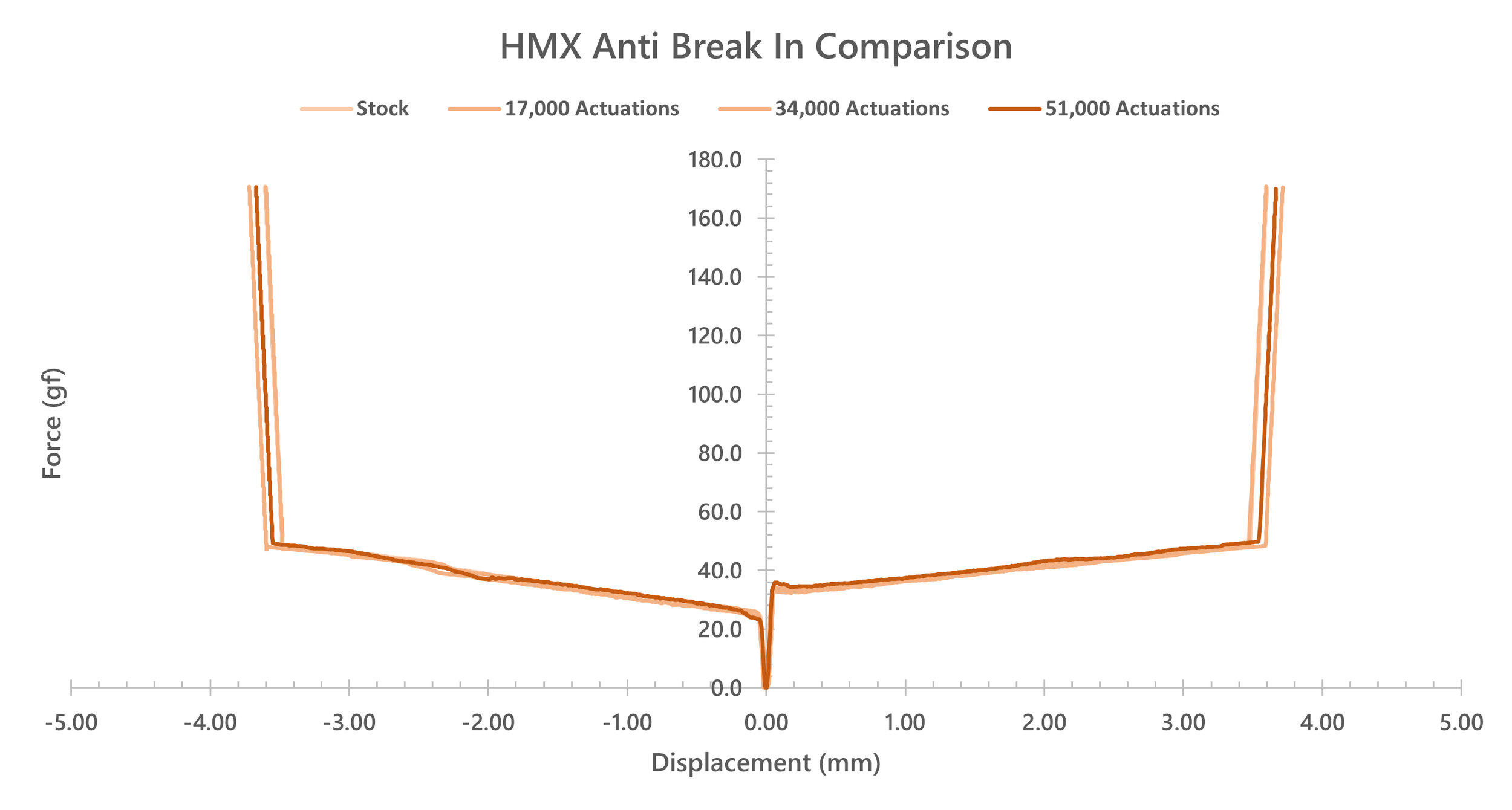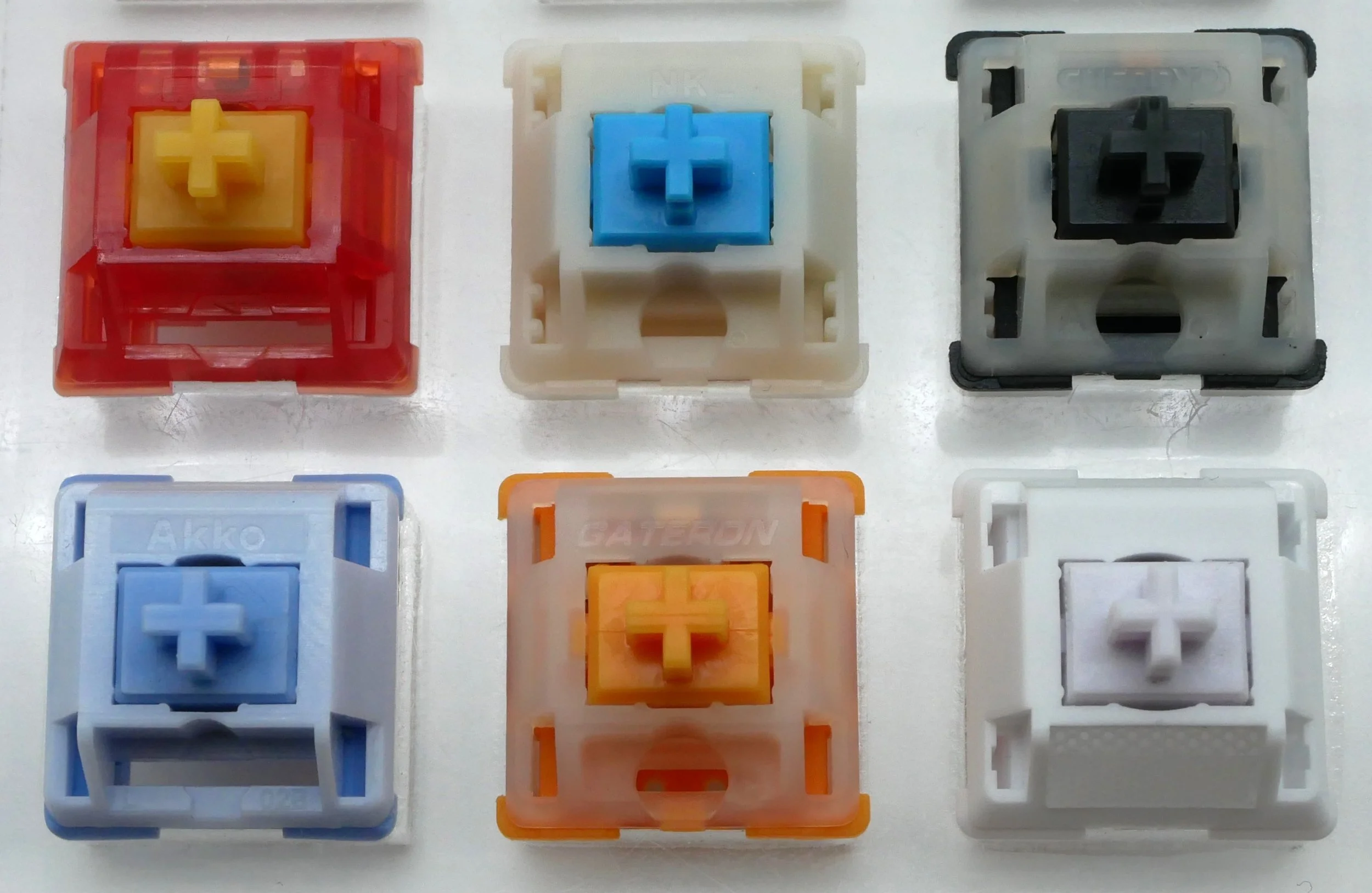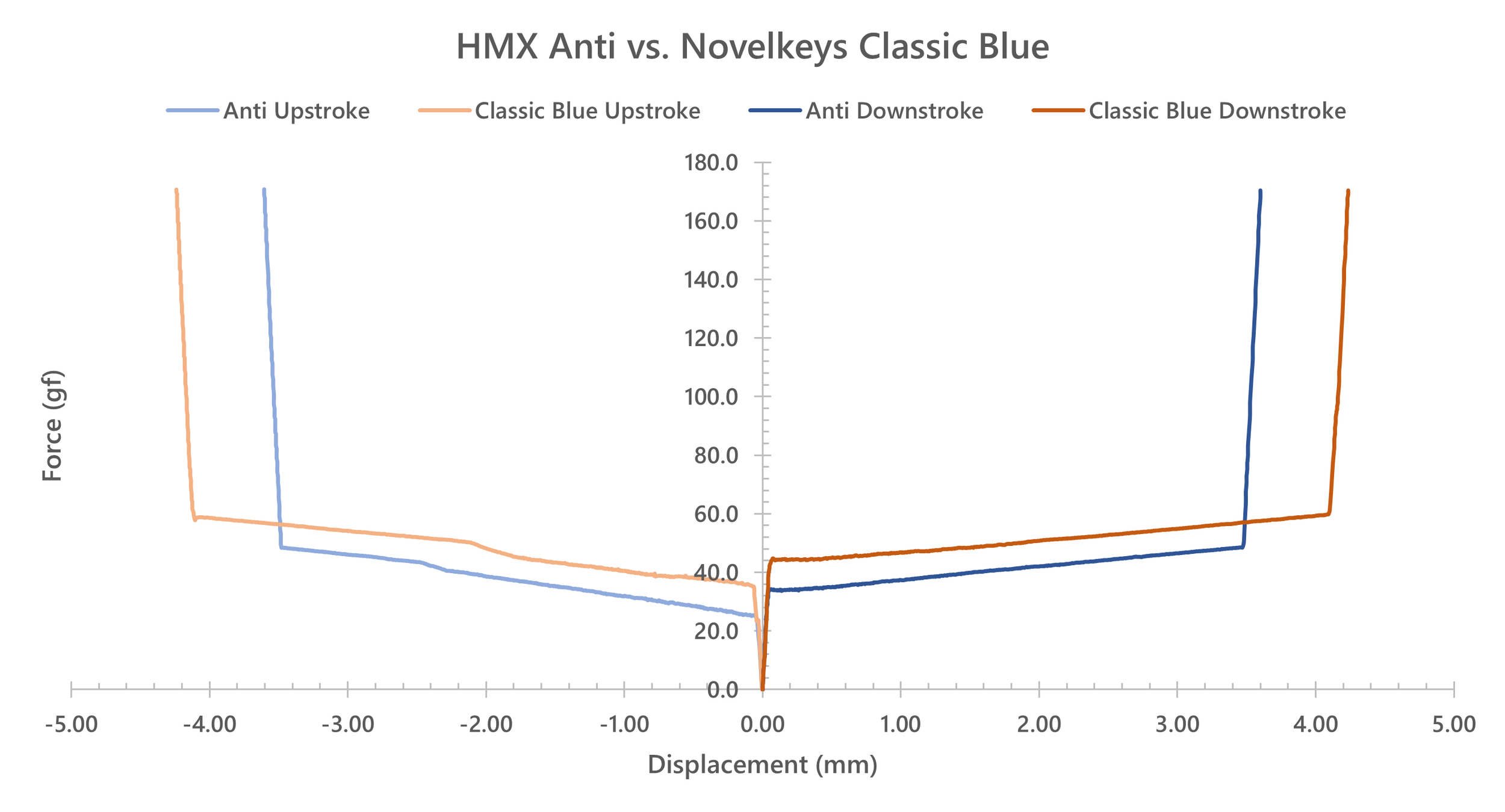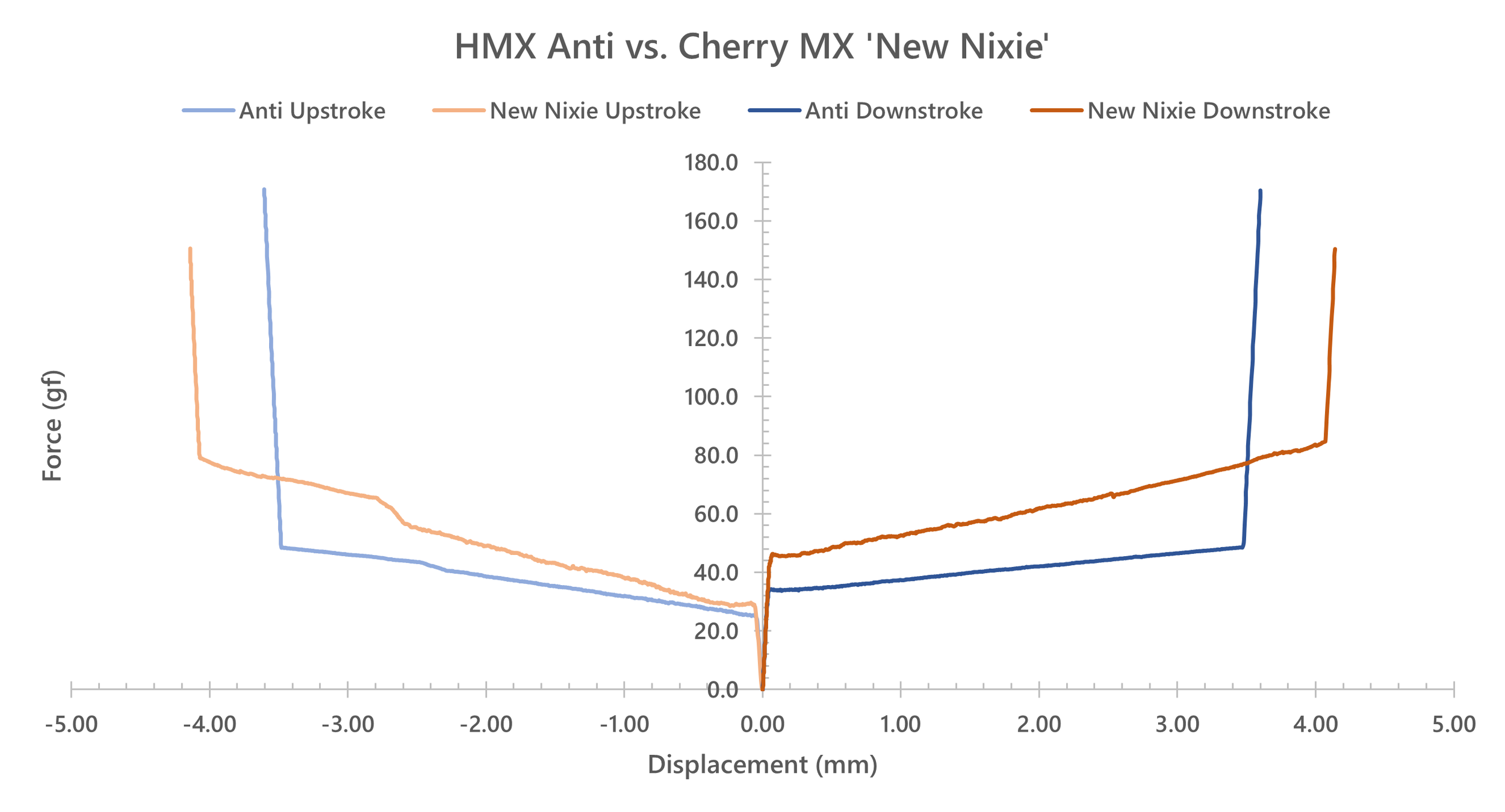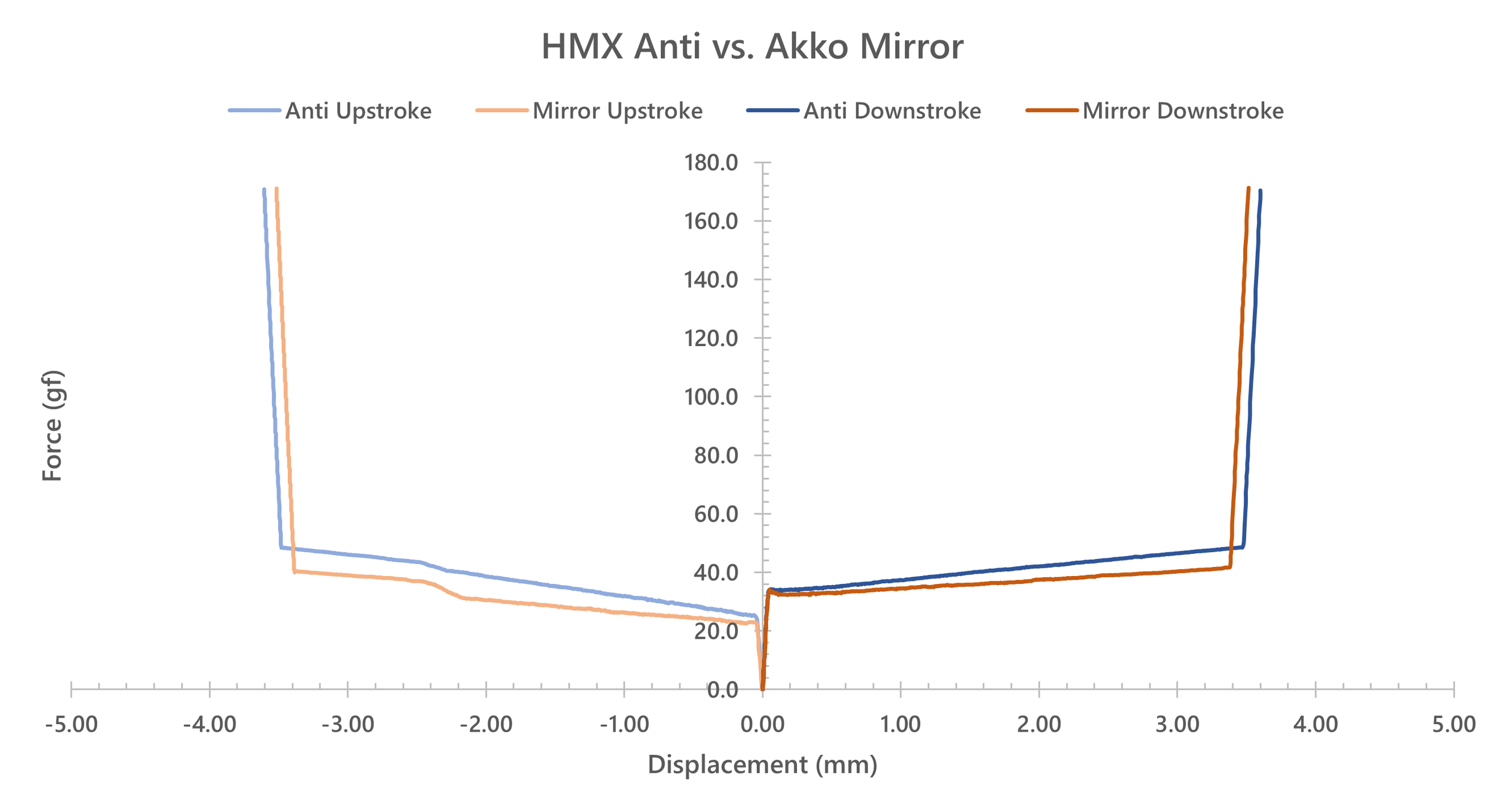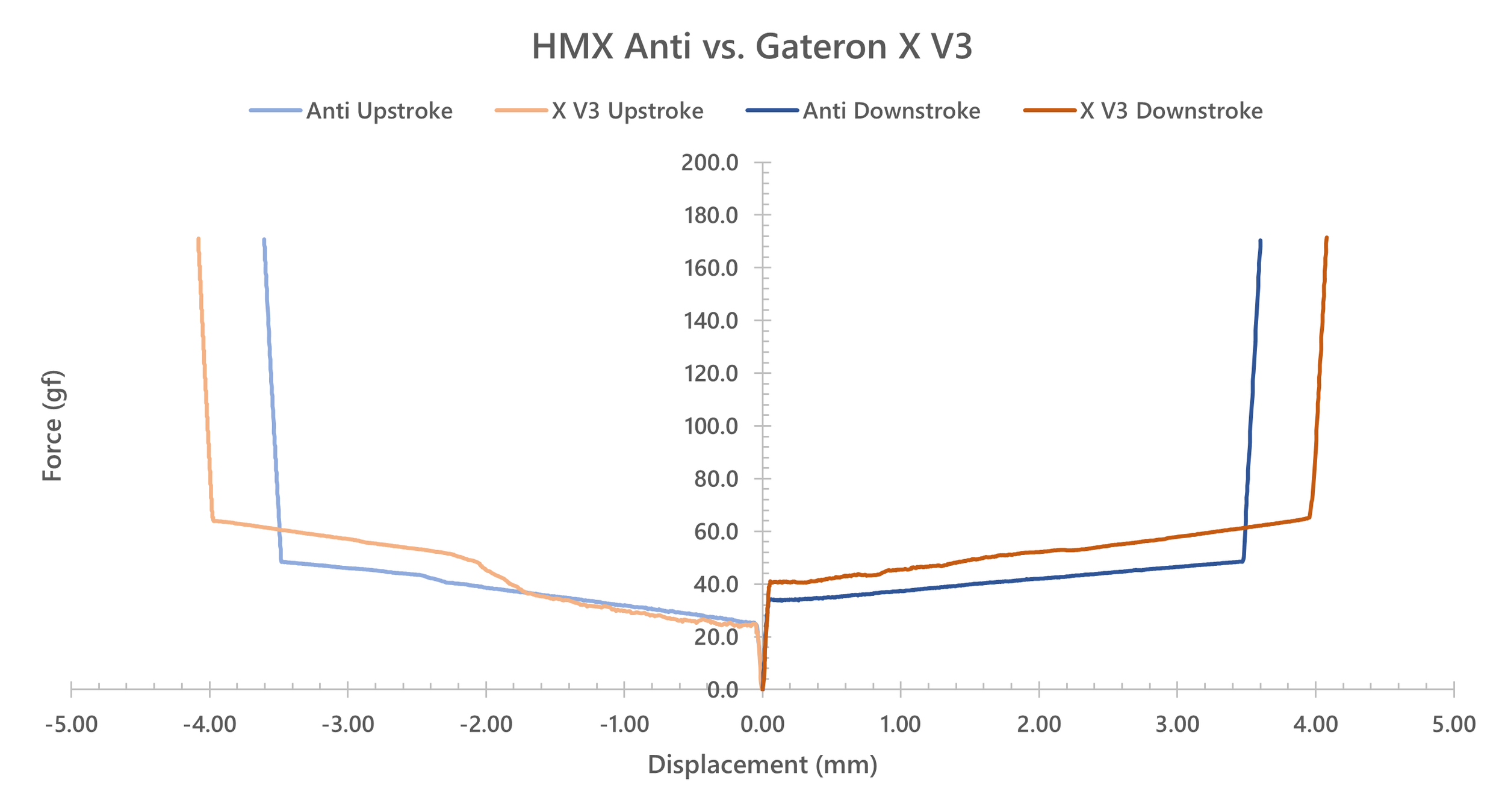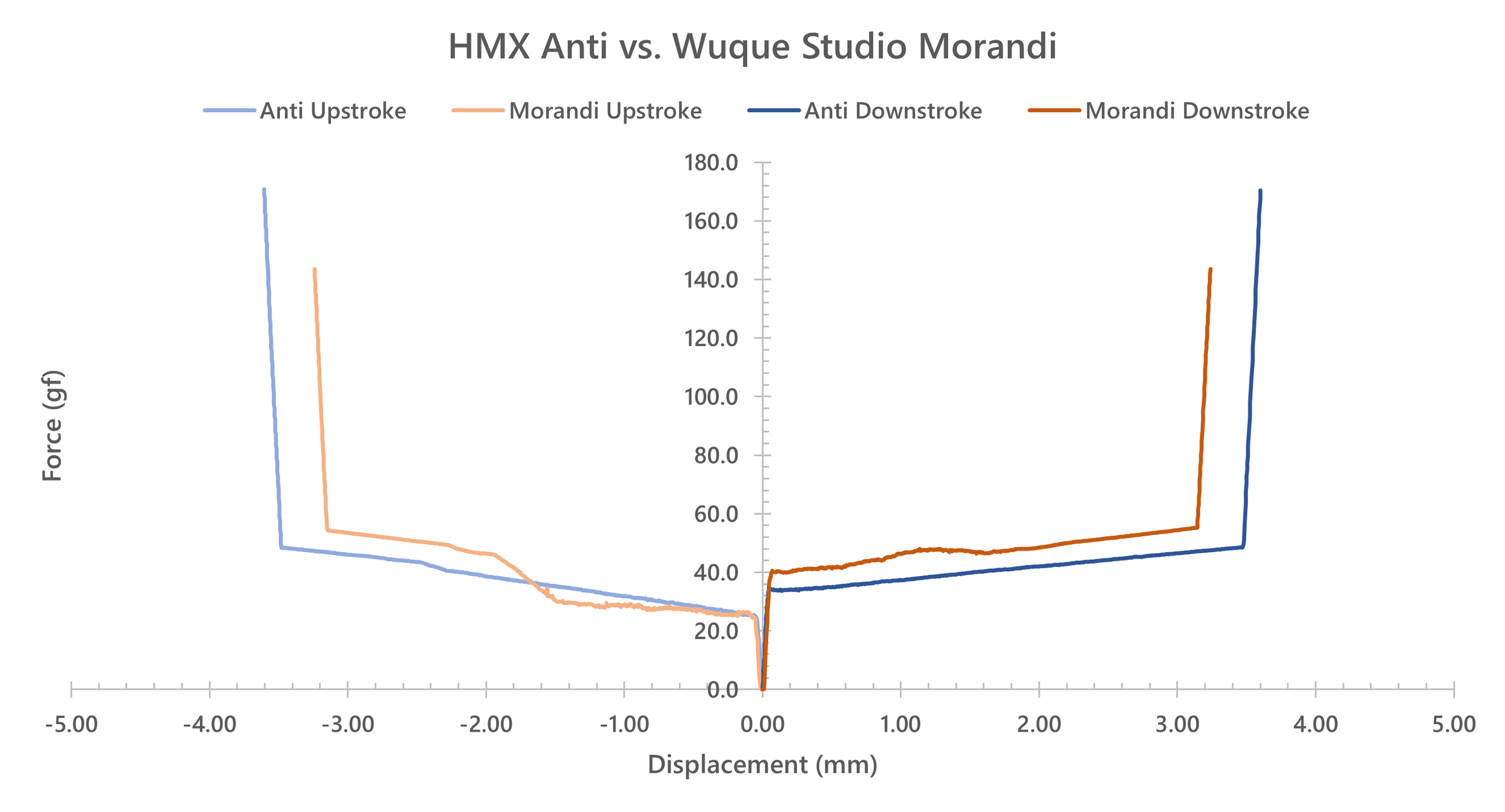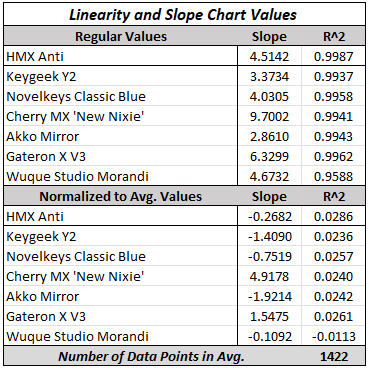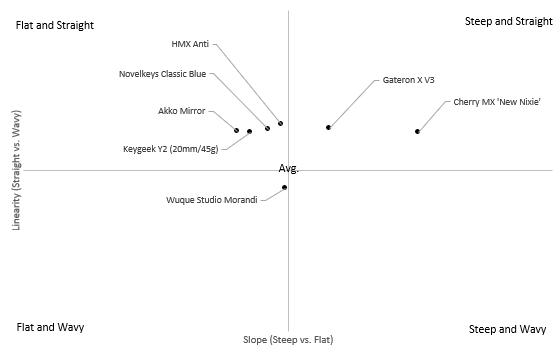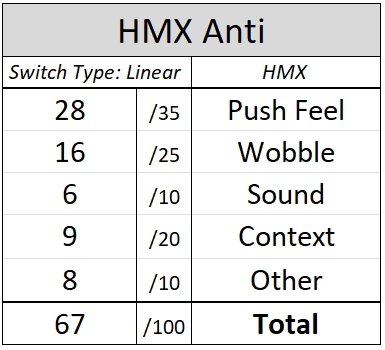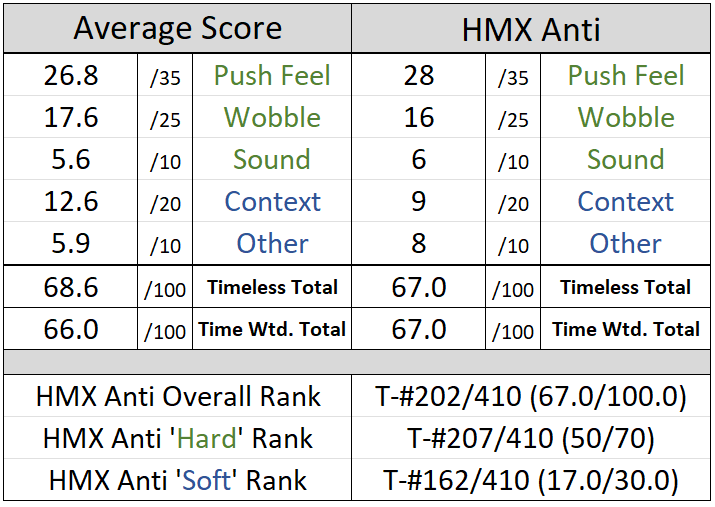HMX Anti Switch Review
We’re less than a week away from Thanksgiving here in the US and the majority of you all reading this know well and truly what all that entails. As for the smaller, but still sizable portion of my audience outside of the US, this holiday and the handful of days around it consist of time off from work and school, shopping, arguments with in-laws and/or distant family members you rarely see, and a wide array of food. Like all things American, as well, all of those things come in excessive amounts of abundance. Strangely enough, though, I find my holiday week shaping up to be one quite a bit different than those traditions as I’ve really just got an abundance of chores and tasks around the house instead of food, arguments, or shopping to be done. (Don’t worry though, there will at least be ~4 hours of watching football in the form of “The Game” between Ohio State and Michigan the Saturday after Thanksgiving.) I’ve got the entire set of brakes to be changed on my car, for one. I’ve got a good bit of costing out and purchasing tools for painting and touching up the trim inside of the house too. Definitely some baking of holiday goods to be done too and maybe work on a side dish or two for a Thanksgiving gathering I’ll surely attend. And most dauntingly I’ve got about a metric ton of switches to add to the collection and formally catalogue. Yes, I have fallen behind on this once again. Those of you who follow me on my various social media platforms will have seen a tiny bit of what this problem looks like when I get a new package of switches in from SwitchOddities, but what you don’t see is that it’s about the 4th order of that size stacked up over the last several months that I’ve been late to get around to documenting. A good 300-400 switches that need to be identified, had their force curves collected, and get measured by calipers are awaiting me and likely to take up the majority of that entirety of the week that I have off. And while that seems like a lot of work that will definitely get a bit old and dull after the first day’s worth of work wears off, surely it will make for good collection photos next year and a good number of articles in the end. So as is traditional to be shared by those celebrating Thanksgiving, this year I am thankful for all of my switches that I’m about to get to formally add to the collection in the coming week – even if that is a bit cliché of me to say.
Figure 1: I've got way more than 99 problems and switches definitely are many of them...
Switch Background
One of the things that I am most thankful for about switches, other than their direct enabling of me to write thousands upon thousands of words’ worth of reviews week in and out, is that they come in such a wide variety of types and forms. Spanning from the oldest vintage designs all that way up through the cutting edges of the modern MX platform, and ranging from lightweight linears to heavy clickies, there’s seemingly a switch out there for just about anyone and everyone interested in keyboards. And there’s more switches basically coming out by the day still! Despite the MX switch footprint and all of its varities being continuously iterated upon by a continuously growing list of new manufacturers for the past seven or so years now, we’re still coming across new, unique innovations on the design. I mean just take a timely look at those new Gateron Jade Delta switches and their triangular stems which hit the market in between last review and this one as an example of such. The variety and ingenuity is just as apparent to viewers looking back through the entirety of 2025 when considering switches like the Sillyworks x Gateron Type Rs, AEBoards Naevy EC, WS Flux HE, and Gateron Lanes as well, just to name a few. There just seems to be an endless bound of creativity in designs to match the equally endless bound of switches being released. And yet, when you zoom out and look at that boundless creativity at a larger scale, it does seem as if there’s still a relatively large funneling of MX style switch designs into one narrow set of “technically perfect” characteristics – low stem wobble, as smooth as possible, and the “most thocky” or “most clacky” sounding in particular. Despite trying to stand out from the crowd and capture some degree of the mechanical keyboard community’s attention in doing so, a lot of these switches end up trying to walk down the same path of dozens, if not hundreds before them. It just seems as if there’s exceedingly few individuals who will really goes out of their way to try and pursue a switch design or twist on the MX footprint that is truly unique or truly standalone, and especially so when that uniqueness lies in unorthodox, conventionally ‘less than stellar’ design spaces.
Figure 2: What I'm really saying is we should set the designers of cheap, OEM-style clicky switch mechanisms loose on the rest of the switch types out there.
Switches that have directional springs that can be turned upside down to produce and entirely new feeling switch, switches which widely swing from tactile to clicky over the course of their lifespan, and switches with so loose of tolerances that their stems practically flap around in their housings are all the kinds of switches that I remember the most about as a long time collector and reviewer of switches. (They’re so memorable that I’m even more likely to remember playing around with or discovering them than even some of the switches I wrote full reviews on a couple of years ago.) These tickle such a fun part of my brain, in fact, that these are the exact kind of switches that I would want to try and make myself if I ever seized the opportunity to collaborate with a manufacturer. No seriously, I’d hate to try making “ThereminGoat’s Best Linear Switch Ever” because the expectations of a switch that I’d slap my name onto would be so exponentially high that I could never, ever deliver something that would satisfy the expectations drummed up by people prior to testing them out in hand. I’d want to try and attempt to make an MX switch that is so bizarre or out there as a way to satisfy my own personal aesthetic or technical curiosities. If we’re not talking about a switch that fills in ‘historical design gaps’ that bother me as a collector such as non-dustproof Gateron Ink Yellow switches, then trying to design a switch that has a multi-bump style tactility to it would pique my interest. Or trying to make an MX switch with the longest or shortest functional stems ever. Maybe even designing switches to intentionally be the scratchiest to ever make it into the hands of customers would be a fun design challenge to try and tackle. All of these sorts of designs fit into a category in my mind called “superlative switches”, and its filled with ones that are trying to be the most, the least, the best, or the absolute worst of some criteria I normally pick apart here in my full length reviews. That is what I mean when I think of switches that are truly stand out in their uniqueness or peculiarities. And while I am of course biased in favor of those out there designs for all of the reasons I’ve listed above, I also do genuinely think that these kinds of designs benefit the community at large and expand the offerings available to fill niches of design we don’t even realize we want yet. I think you should want switches that are this odd too.
While perhaps not nearly as extreme as the “superlative switches” that I would push into production myself, it’s this exact kind of desire to seek out the less-than-orthodox that drew me like a magnet to the HMX Anti switches – ones which I’m almost certain you didn’t seek marketing for anywhere. In fact these switches hardly have any background to them at all, let alone marketing, with the entirety of their history being able to be summed up in just two ZFrontier posts (which very questionably translate from Chinese to English) and a tiny bit of English marketing of them by Unikeys, one of their main resellers. And yet its clear from even these few posts that they were designed to be ‘different’ in a not-so-normal kind of way. As I can scrape together from the translations, the HMX Anti switches were designed by Unlimited Studio to not be like any other HMX switches before them, but rather to be designed like a manufacturer they have nothing but effusive praise for – JWK. Sensing a bit of irony and sarcasm in the posting that really does not translate between languages well, these posts read as if the Unlimited Studio team is mocking the “extreme smoothness” of older JWK switches as well as their rather notable strive to drive down stem wobble in their switches at all cost by making an HMX switch that simultaneously mimics the performance old JWK switches and brings HMX switches down to their level in the process. An anti-HMX switch, if you will. Not satisfied to just make this a meme post and be done, the team went on to develop new molds with HMX that “give up on almost all stem stability to bring the extreme smoothness of the old JWK switches”, or more directly produce HMX switches that are more wobbly, more scratchy, and less clean sounding than their other HMX switch counterparts. If that doesn’t strike you as a stand out concept that truly is different than most other switches on the market, I’m not really sure what would. While I can fully recognize that the HMX Anti swtiches do appear to largely be a meme executed to the fullest degree – something which makes them strangely enough the second to do so at the expense of a JWK-made switch because of the Revo-backed Opgrey switches from 2021 – it’s definitely a bold choice on Unlimited Studio’s behalf.
Figure 3: Seriously, the ZFrontier posts do not translate well at all.
Figure 4: Am I doing this meme thing right?
What’s further ironic about the HMX Anti switches is that they opted for a one-ish time drop, relatively low volume sales method that is highly disconnected from the norm of switches that tend to be stocked by and for western audiences through vendors like Unikeys. Eschewing the norm of producing multiple distinct rounds of switches, porting large volumes of switches directly to vendors, or even being clear about their goals, the Unlimited Studio team really did just seem to say ‘fuck it’ and threw out a release date of October 17th, 2025 and rough volume of 30,000 switches that may or may not be restocked at some point again on their TaoBao store front. No other marketing, no other sales pitch, and hardly any engagement with their supports in the ZFrontier comments either. Priced initially at 1.68 yuan per switch ($0.24/switch) for the first two days and then increased to 1.88 yuan/switch ($0.26/switch) after October 19th, these wobbly and scratchy nylon housing HMX switches came in packs of 10, 70, 90, and 110 as well as two different weightings as of the time of their release – a 37gf variant with a 22 mm-long spring and a 45gf variant with 18-mm long springs. While still able to be purchased from Unlimited Studio’s TaoBao storefront as of the time of writing this review, westerners are more likely to be able to easily access these through vendors like Unikeys and Milktooth which import switches like these frequently and sell them at slightly higher costs than the initial groupbuy sales prices to offset shipping. If it wasn’t incredibly obvious from how I described Unlimited Studio’s ZFrontier posting and memetic switch design strategy, I have absolutely no clue how long these switches will be available for.
Figure 5: Marketing photos of the HMX Anti switches from ZFrontier user 'Golden Wheel's Secret Keyboard'.
HMX Anti Performance
Note: I purchased my HMX Anti switches from Unikeys for this review and was only offered one variety of them for purchase. Based on the measurements conducted below, it appears that this review is for the 45gf, 18-mm spring variant of the HMX Anti switches. I do not own any of the 37 gf, 22-mm spring variants for comparison’s sake.
Appearance
At the highest level, the HMX Anti switches come in a three-part colorway that I can really only summarize as “vaguely pink” in tone. Despite the marketing photos from the ZFrontier post making these seem quite vibrant and in line with the cutesy vibe that most keyboard switches tend to try and shoot for, in hand these switches are actually significantly toned down and almost pastel in appearance. This is something that is especially applicable to the opaque, barely pinkish bottom housings. In direct lighting the top housings are a translucent milky pink color that shifts almost purple-greyish in tones in indirect lighting, seemingly only still readable as pink because of their proximity to the bottom housings. And as for the stems they’re white-ish? Off-white? Eggshell? You’d think with all of the paint swatches I’ve looked at for the house in the last week that I would have a better description for this color, but alas I really do not. As a whole this colorway is definitely unique in its (lack of) vibrancy and color combination and almost certainly able to stand out amidst a pile of other switches. That being said, though, the HMX Antis do lack any sort of branding from either HMX or Unlimited Studio that will make these a little hard for the average enthusiast to identify months or years down the road when they stopped being stocked. Given that the HMX Anti switches were purportedly made with new molds of an unknown specification, as well as the fact that this is a long form switch review, there’s quite a few details worth nothing here at the part and sub-part level of the various components of these switches. Discussion of these details of note may be found in the paragraphs and photos below.
Figure 6: HMX Anti switches and their components.
Looking first to the milky pink, pale translucent top housings of the HMX Anti switches, I really struggle to find any details that make these distinctively different from the other HMX top housings I’ve covered at length on this website such as in the Akko Cilantro Switch Review. While the small bit of marketing information from Unlimited Studio was not specific as to which parts of the Anti switches had had new molds created for them, it’s fairly reasonable to assume that it had to be at least either the top housings or stems as a direct result of the intentionally increased stem wobble. And yet, all of the details of the Antis line up identically to that of the Cilantros save for the blank nameplates on the Anti’s housings. The top housing exteriors feature four attachment pins, normal proportions, and a wide rectangular LED slot with centered circular indentation and a three part mold marking located on the outer right-hand edge of this housing. Internally all of the mold ejector marks and notches cut into the outer ring of the housing where it contacts the bottom housings are all in identical places as well too. Even the rectangular hole of the Anti switches measures exactly identically to that of the Cilantros in both the horizontal and vertical direction. So while the housings very clearly have signs that suggest they are of HMX origin, it does not seem like these are the components with the newer molds.
Figure 7: HMX Anti switch top housing exterior showing blank nameplate, wide rectangular LED/diode slot with centered circular indentation, and mold marking located on lower right-hand edge of that slot.
Figure 8: HMX Anti switch top housing interior showing numerous features and mold markings identical to that of other HMX-made switches from recent years.
Moving next to the opaque, kinda-white-ish colored stems of the HMX Anti switches, I’m met with a set of physical details that carry with them a similar degree of irony as was clearly used in the inception of their design and the switch at large. On the surface these stems appear incredibly plain. They appear a bit long in the center pole, but otherwise feature non-tapered slider rails that are purely rectangular, a sharply tiered center pole, and an overall fairly average, unassuming look to them. Even the factory lubing is sparsely applied to the sides of the stem in such a way that it just screams ‘average’. And yet despite their rather blasé appearance, the measurements I recorded in sections below clearly point to these being the component with the new molds required for them. The HMX Anti stems are anywhere from a fraction of a millimeter all the way up to almost half a millimeter different from the Akko Cilantro stems in nearly every direction with the exception of their stem pole lengths which are identical, meaning that the stem wobble was clearly just designed by shrinking the entirety of the stems within the HMX housings to allow them to move around more. In fact if you directly compare the measurements to the other 27 HMX switches I’ve taken calipers to as of the time of writing this review, the HMX Anti switches are the smallest in multiple dimensions across their stems. It’s kind of a hilarious just how simple of a tweak appears to have been made to make them more wobbly.
Figure 9: Front and backside of the HMX Anti stems showing non-tapered slider rails, strongly tiered center poles, and front plate mold ejector circles.
Finally arriving to the pastel pink bottom housings of the HMX Anti switches, we once again return to a design that has strong visual and statistical commonality with other HMX switches. Internally the bottom housings feature a strong south side spring collar, dampening pads at the base of the perfectly rectangular slider rails, and hardly any factory lubing scattered around these features. In fact there’s so little factory lubing noticeable here in the housings that it must largely stay on the stems in stock with the exception of the large white blobs of lube that can be seen on the leaves at their interface with the stems’ legs. Externally the HMX Anti housing come only in five pin/PCB mount variety and feature a small, inverted numerical mold marking that is commonly associated with HMX switches. The bottom housings of the HMX Anti switches also do feature the ‘right side up’ and ‘inverted L’ shapes on the bottom housings underneath of the PCB mounting pins like that of the Akko Cilantro switches which I’ve referenced here a couple of times, though the right-hand one also appears to have a number attached to it which is different than previous HMX switches I’ve seen. I’m uncertain if that means the bottom housings were also subject to some adjustments that required new molds be made.
Figure 10: HMX Anti switch bottom housing interior showing south side spring collar, dampening pads at the base of the slider rails, and generous amounts of factory lubing on the stem leg/leaf interface.
Figure 11: HMX Anti switch bottom housing exterior showing PCB mounting pins and mold markings both in the center top and lower left- and right-hand corners in line with other HMX-made switches from over the years.
Push Feel
You know, for being a linear switch that was designed with an intentional degree of scratch – something which loads a lot of mental baggage into the expectations going into first testing the switch – I think most people would be surprised how pleasant the HMX Anti switch feel overall. The combination of the sparse but noticeably effective factory lubing makes the switches feel smooth, though just barely enough to take a lot of the harsher, more sandpapery like edge away from their scratch while still maintaining it a tiny bit. Throughout both upstrokes and downstrokes, the Anti switches have an almost shuffling sort of scratch that is incredibly fine in grain and gives these linears a character and depth that otherwise overly lubed switches simply wouldn’t have. Pairing this up with the firm but not black hole-like housing collisions that feel deep and cushioned despite the shortened bottom out length of these stems around 3.50 mm, the result is a compact, tight feeling linear switch. While the topping outs of the HMX Antis are similar in strength and depth of feeling to the bottom outs at normal typing speeds, they do suffer a bit from inconsistency and variation at different typing speeds. In fact both the topping outs and the fine grain soft scratch of the Antis become a bit more noticeable at higher actuation speeds and give the switches an almost thinner, lighter feeling than the depth present at slow speeds. Speaking of light as well, I imagine there are quite a few enthusiasts that would be afraid of using these switches on account of their light (for western audiences) spring weighting of ~45 gf. In hand, though, the Antis don’t feel that light at all. They certainly don’t feel heavier as if they were 60 or 70 gf of force, though what they do have is enough texture and depth from the scratch and housing collisions that prevents the stems from feeling like they’re being tossed around with no effort. As well, the force curves for these switches are rather flat and thus don’t start out at a wobbly, soft 20 gf before slowly working their way up to that bottom out weight – they start out a few grams short of the mark and only move a handful of grams of force over their whole stroke making it harder to notice just how light they are.
Figure 12: Force curve diagram for the stock HMX Anti switch.
Sound
In a relatively rare combination of performance notes, the HMX Anti switches actually sound significantly less scratchy than they feel in hand. In fact I’d go so far as to say the better half of the Anti switches just don’t sound scratchy in the slightest. While the push feeling notes above would suggest that these switches might have a shuffling, soft scratch tone that would penetrate throughout the entirety of their strokes like many other scratchy switches before these have, they just simply don’t have that noise at all. Instead, the primary driving force of sound in the HMX Anti switches is their housing collisions and especially the bottom outs. These bottom outs carry a deep, low volume collision that is short, slightly rounded, and ‘poppy’ in a way that does a really good job of emphasizing the tight and compact feeling that the push feeling of these switches is trying to sell. The topping outs do leave a bit of room to be desired here though as they are a bit thinner and higher pitched, something which also increases in prevalence at higher actuation speeds in addition to an increasing snappy sound at topping out. Further unlike the push feeling notes above, the variation in sound of the HMX Anti switches is also a fair bit greater with the range of switches being a bit more varied. While the notes earlier in this paragraph do well to describe the average Anti switch, those that are towards the worse end of the spectrum do feature those light shuffling sounds, do have more disparate housing collisions, and do travel quite a bit further from their starting point as typing speeds increase than the better half of switches. Do I think that this variation is necessarily bad enough that users will need to go through and fully cherry pick through switches in order to get a coherent batch for a build? No, though it is still something that I was able to notice when testing these switches out myself.
Wobble
Believe it or not, they have stem wobble. The HMX Anti switches have a slightly greater than average stem wobble that is more noticeable in the N/S direction than the E/W direction, though certainly noticeable no doubt. Surprisingly, though, I could swear these are not only slightly better than the average Durock/JWK-made switch that Unlimited Studios seemed to be taking shots at in the announcement posts for these switches, but that they are also aren’t all that bad to use. I think anyone who would willingly seek out a switch that is marketed around having wobble baked into its design would have a hard time being upset with how these switches perform on this metric.
Measurements
If you’re into this level of detail about your switches, you should know that I have a switch measurement sheet that logs all of this data, as well as many other cool features which can be found under the ‘Archive’ tab at the top of this page or by clicking on the card above. Known as the ‘Measurement Sheet’, this sheet typically gets updated weekly and aims to take physical measurements of various switch components to compare mold designs on a brand-by-brand basis as well as provide a rough frankenswitching estimation sheet for combining various stems and top housings.
Figure 14: Numerical details regarding the force curve for the stock HMX Anti switches.
Have you ever wanted to be bombarded with more switch data than you’ve ever seen at any point in your life before? Consider checking out the ‘Force Curve Repository’ hosted on my GitHub that contains all force curves that I take both within and outside of these full-length reviews. In addition to having these graphs above, I have various other versions of the graphs, raw data, and my processed data all available for over 1500 different switches for you to use however you see fit. Check it out via the ‘Archive’ tab at the top of this page or by clicking any of the force curve cards above.
Break In
Break In Notes
17,000 Actuations
- After 17,000 acutations, the most notable change in the HMX Anti switches is an increase in the switch to switch inconsistency in both push feeling and sound. While there was some degree of variability amidst the stock batch of switches, its much more pronounced here and definitely bordering on that territory of where users may want to cherry pick switches for ab uild in order to get a matching set.
34,000 Actuations
- The same increase in switch variability that was noted at 17,000 actuations was more or less maintained out to 34,000 actuations. I wasn’t able to separate this batch from the previous one broken in based on this metric.
- There was a slight increase in both N/S and E/W direction stem wobble in the HMX Anti switches broken out this far. (I was somewhat tempted to put a ‘+’ in that box instead of a ‘-‘ given that one of the aims of the stock switches were to be more wobbly, though I feel like that joke won’t transfer nearly as well into the far future.)
51,000 Actuations
- Out at 51,000 actuations, the HMX Anti switches more or less behave like the batches broken in to the previous two stages, though perhaps with just a slight bit more scratch in their feeling. Likely due to migration of the sparse amount of factory lubing that is present, the Anti switches out at 51,000 actuations have strokes that are just a bit rougher than their stock counterparts.
Figure 16: Comparative force curve diagram showing no substantial change in the force curves of the HMX Anti switches throughout the break in process.
Comparison Notes to Other Notable Linear Switches
Note – These are not aimed at being comprehensive comparisons between all factors of these switches as this would simply be too long for this writeup. These are little notes of interest I generated when comparing these switches to the HMX Anti switches side by side.
Figure 17: Switches for comparison. (L-R, Top-Bot: Keygeek Y2, Novelkeys Classic Blue, Cherry MX 'New Nixie', Akko Mirror, Gateron X V3, and Wuque Studio Morandi)
Keygeek Y2
- There’s a bit less E/W and especially N/S direction stem wobble in the Keygeek Y2 switches than there is in the stock HMX Anti switches.
- Both the Keygeek Y2 and HMX Anti switches are surprisingly similar to one another when it comes to portions of their sound profiles such as their volume, bottom out sounds, and overall depth. These switches are both on the quieter side with deep, slightly forceful housing collisions that are well balanced, though where they depart is in their strokes – with the heavy factory lubing of the Keygeek Y2s making them sound much more insulated than the more textured, scratchy sound of the Antis.
- The comparative force curve between these two switches below is actually pretty true to form, and especially so with respect to their bottom outs. Under finger the Y2 switches definitely feel as if they travel a fair bit further into their downstrokes than the HMX Antis.
Novelkeys Classic Blue
- There’s hardly any competition when it comes to comparing stem wobble of these two switches as the Novelkeys Classic Blues just absolutely blow the HMX Anti switches out of the water.
- Much like with the Keygeek Y2 switches above, the Novelkeys Classic Blue switches are significantly more heavily and thoroughly lubed than the Keygeek Y2 switches and thus feel as if they have more drag and less character in their strokes than the Anti switches.
- While the comparative force curve between these two switches below is fairly true to what they feel like in hand, the heavier factory lubing on the Novelkeys Classic Blues really does make them feel more heavy and forceful to push through than the Anti despite the relatively small gap between them in the chart.
Cherry MX ‘New Nixie’
- In terms of their out of the box smoothness, the Cherry MX New Nixie and HMX Anti switches are actually fairly comparable to one another. The scratchiness of the New Nixies is definitely feels more rough and dry, and less like a precisely chosen amount of scratchiness like in the HMX Antis.
- The Cherry MX ‘New Nixie’ switches are also among the rare set of switches that have asymmetrical stem wobble, though in opposite fashion of the Antis they have less N/S direction stem wobble than E/W direction wobble. Doing my best to quantify these differences anyways, it does seem as if the Antis on the whole have a bit greater stem wobble.
- These two switches are fairly comparable to one another in terms of their overall sounds, though the New Nixie switches definitely have a bit more of a ‘black hole’ style of bottom out which just completely deadens almost all noise of the stem on impact as opposed to the slight audible feedback of the Anti switches.
Akko Mirror
- Given that the Akko Mirror switches are more prototypical HMX switches, they of course have much less stem wobble than the out there, specifically-designed-for-this HMX Anti switches.
- As a result of the precise and incredibly smooth factory lubing on the Akko Mirror switches, they actually feel significantly lighter underneath the fingers than the HMX Anti switches. I was a bit blown away by just how similar the force curves between these two switches were as I would have sworn the Anti switches would have been heavier after comparing them head to head.
- In terms of their sound profiles, the Akko Mirrors are much more high pitched, pointed, and sharp sounding than the soft shuffling scratch and dampened bottom outs of the HMX Anti switches.
Gateron X V3
- Despite there being other HMX-made switches on this list, as well as ones that are historically known for being scratchy, the Gateron X V3 switches are surprisingly the ones which are most similar to the HMX Anti switches out of all of the switches on this list – even down to comparable overall amounts of stem wobble.
- For all the similarities that they do have, though, the X V3 switches are just a tiny bit more smooth than the Anti switches and don’t quite have that characteristic feeling to their strokes that embodies a noticeable amount of depth.
- The comparative force curve between these two switches surprisingly does not align with the in hand experience much at all, with the X V3 switches feeling quite a fair bit lighter in weight through all points in their downstroke than the HMX Antis.
Wuque Studio Morandi
- Comparing the bottom out sound and feeling between these two switches, the Wuque Studio Morandis are quite a bit deeper, firm, and more muted sounding than the already fairly solid HMX Anti switches. This difference is especially noticeable in their sound profiles, wherein the Morandis just have this extra bit of roundedness and complexity to their bottom outs that the HMX Anti switches, as well as most other switches, just don’t have.
- There’s a bit less stem wobble in the N/S and E/W directions of the Morandi switches than there is in the HMX Anti switches.
- The comparative force curve between these two switches below is fairly true to form, with the Morandi switches definitely feeling heavier and as if they bottom out much sooner than the lighter, longer stretching HMX Anti switches.
Linearity
Figure 24: Absolute and relative Linearity and Slope values for each switch in this comparison section.
Figure 25: Qualitative comparison of the normalized Slope and Linearity for each switch in this comparison section.
If you are just now seeing this section for the first time and are a bit confused as to what I am talking about when discussing ‘Slope’ and ‘Linearity’, I highly suggest checking out my article titled ‘On Differences in Linear Switches’ where I explain what this section is for and how it came to be! For a bit of a shorter answer, know that this is part of my ongoing attempt to better quantify and articulate differences between linear switches which have historically not been captured in discussions about them.
Scores and Statistics
Note – These scores are not necessarily completely indicative of the nuanced review above. If you’ve skipped straight to this section, I can only recommend that you at least glance at the other sections above in order to get a stronger idea of my opinion about these switches.
Push Feel
In pursuit of a feeling truly unlike any HMX switch before it, designer Unlimited Studio sought out new stem molds and precise factory lubing conditions to make the Anti switches… scratchy. Though they aren’t scratchy in a bad way, rather they have just enough precise factory lubing to leave them feeling like smooth linears but with a soft, shuffling sort of scratch that gives their feeling depth and character. Rounded out with firm but still noticeable housing collisions that dampen out the ends of the strokes and we’re left with an overall subtle but distinctive linear.
Wobble
Not content with just making a scratchy switch, the Antis were also designed to be more wobbly than a standard HMX switch and as a result have a greater than average N/S direction wobble and lesser but still noticeable E/W direction give.
Sound
While the HMX Anti switches are far from technically perfect on account of their more audibly noticeable soft scratching sounds at higher actuation speeds and general switch to switch variability in bottom out intensity and depth, they make for a tight and cozy switch which is overall quiet but with touches of character and depth as a result of their planned shortcomings.
Context
Available anywhere from $0.28 to $0.40 per switch depending on where they are purchased from, the HMX Anti switches are an interesting proposition for their value though just extremely unlikely to be widely months down the road. They are more so an interesting proposition of a switch run than they are anything that would sustain long term community attention.
Other
The design intent to push these switches out into uncommon waters by making them scratchier and more wobbly is one I simply have to applaud. While I think they could have gone further, the Antis make for a fun ‘what if’ experiment more vendors and manufacturers should explore.
Statistics
If you are looking at this statistics section and wondering what the heck ‘Timeless’ and ‘Time Weighted’ scoring is, consider checking out my short article titled ‘A Scorecard Time Change’. As a result of scoring becoming a bit anachronistic over the years, switches are now ranked in this statistics table using a “time weighted total” as opposed to their day-of scoring as discussed in that article. If you’d also like to learn about what ‘hard’ versus ‘soft’ ranks refer to specifically, I’d encourage you to head on over to my GitHub linked in the table above or at the links in the top right hand of this website to check out my database of scorecards as well as the ‘Composite Score Sheet’ which has a full listing of the rankings for each and every switch I’ve ranked thus far.
Final Conclusions
Despite the lack of community fanfare and overall marketing leading up to the present day, the HMX Anti switches are certainly one of the more memorable switches that I’ll have written a full length review for this year. Previously I’ve detailed switches that have basically no marketing to them prior to hitting my hands and the pages of a full length review. I’ve also previously gone over switches that have less than stellar performance attributes as well. However, I can’t recall the last time that I organically came across a switch that simultaneously fits into both of these categories while also not feeling like they did so accidentally somewhere along the way. Designed by Unlimited Studios to be a more wobbly, more scratchy, and less-like-every-other-HMX-switch linear, the HMX Antis achieve exactly that; They are scratchier than normal, more wobbly than the conventional HMX switch, and even achieve the goal implicitly by having a very small marketing presence for HMX which has been a large player in the linear switch space for the west throughout 2025. I could point to the clear and present shortcomings of these switches as well as their batch-wide and typing speed-based variability, but ultimately that feels a bit… undeserved?... of me to dog on them for it. These switches are far from technically perfect but that’s almost exactly what they’re trying to be – rough around the edges, with some ‘flaws’ that many manufacturers would try and avoid, and with a low market profile in doing so. Their scoring above clearly reflects these truths, but I have to admit that I kind of like them more than what that score (or the rest of the tone of this review) would suggest. Certainly a good number of linear switch fans won’t like them, but I do. I can deeply appreciate the intent of Unlimited Studio to strike down the path less traveled and in doing so pursue something notably different, even if different means a bit worse. It gives the switches a character and (lack of) polish that separates them from the rest of the switches dominating the market currently. The HMX Antis are a perfect example of a switch that continues to make collecting, reviewing, and being an enjoyer of MX switches interesting multiple years down the road and I can only hope that these will inspire more vendors and manufacturers to strike down this path less traveled at some point in the future – even if it is by making their switches “worse” by all normal metrics.
Sponsors/Affiliates
Mechbox UK
- A wonderful UK based operation which sells singles to switches that I’ve used above in my comparisons for collectors and the curious alike. Matt has gone out of his way to help me build out big parts of my collection, and buying something using this link supports him as well as my content!
KeebCats UK
- A switch peripheral company based out of the UK which sells everything switch adjacent you could ask for, they’ve been a huge help recently with my film and lube supply for personal builds, and they want to extend that help to you too. Use code ‘GOAT’ for 10% off your order when you check them out!
proto[Typist] Keyboards
- An all-things keyboard vendor based out of the UK, proto[Typist] is a regular stocker of everything from switches to the latest keyboard and keycap groupbuys. While I’ve bought things from the many times in the past, they also are a sponsor of my work and allow me to get some of the great switches I write about!
Divinikey
- Not only do they stock just about everything related to keyboards and switches, but they’re super friendly and ship out pretty quick too. Divinikey has been a huge help to me and my builds over the last year or two of doing reviews and they’ll definitely hook you up. Use code ‘GOAT’ for 5% off your order when you check them out!
ZealPC
- Do they really need any introduction? Zeal and crew kicked off the custom switch scene many years ago with their iconic Zealios switches and the story of switches today couldn’t be told without them. Use code ‘GOAT’ (or click the link above) for 5% off your order when you check them out!
MechMods UK
- A rising vendor based in the UK, Ryan and crew have been a pleasure to work with and have nearly everything you’d need to build your first or fourteenth keyboard. Go build your latest or greatest one right now with them by using code ‘GOAT’ at checkout for a 5% discount!
Dangkeebs
- A longtime supporter of the website and the collection, Dangkeebs has quite possibly the widest variety of switches of any vendor out there. Not only is their switch selection large, but it rotates and is constantly adding new stuff too. You’re going to need 5% off your order with my affiliate to save off the cost of all those switches!
SwitchOddities
- The brainchild of one my most adventurous proxies, SwitchOddities is a place where you can try out all the fancy, strange, and eastern-exclusive switches that I flex on my maildays with. Follow my affiliate code and use code ‘GOAT’ at checkout to save 5% on some of the most interesting switches you’ll ever try!
Cannonkeys
- Does anybody not know of Cannonkeys at this point? One of the largest vendors in North America with keyboards, switches, keycaps, and literally everything you could ever want for a keyboard always in stock and with an incredibly dedicated and loving crew. Follow my affiliate link above in their name to support both them and I when you buy yourself some switches!
Kinetic Labs
- One of the most well-rounded keyboard vendors out there, Christian and crew have been supporters of all my switch and switch-adjacent needs for some years now. I’m honored to have them as an affiliate and think you should check them out using my affiliate link above to support both them and I when you check out their awesome products!
Keebhut
- Want to try out some switch brands that fly under most vendor’s radars? Keebhut is always seeking out that next latest and greatest and has been super helpful in hooking me up with new brands over the past year. They are all about sharing that love as well, and want to give you 5% off your next order with them when you use code ‘GOAT’ at checkout!
Kailh
- No, you’re not mistaken – this is actually that Kailh that manufactures switches. As one of the longest running manufacturers in the hobby, they have a massive variety of switches available over on their website at any point in time. I’m lucky to be affiliated with them now, and so consider using my affiliate link above when ordering some Kailh switches to support me!
Keebz N Cables
- Australia and Oceania’s very own is now a part of the sponsor list here and I couldn’t be happier to add this long time supporter of the collection to it. They’ve always got an amazing selection of switches (and other keyboard parts) in stock and they want to share the love that they’ve shown me with you all too! Use code ‘thegoat’ for 5% off your first order when you visit!
Further Reading
HMX Anti ZFrontier Interest Check
HMX Anti ZFrontier Groupbuy Announcement
Unikeys’ HMX Anti Switch Sales Page
Milktooth’s HMX Anti Switch Sales Page
Unikeys’ HMX Anti Instagram Announcement
Keyboard_Dad’s HMX Anti Switch Instagram Post
KS Japan’s HMX Anti Switch Typing Test
